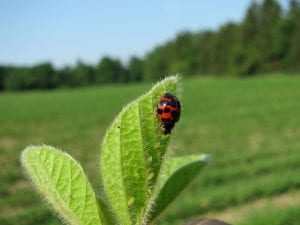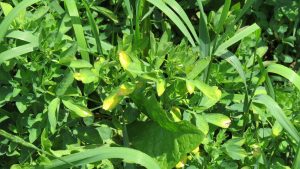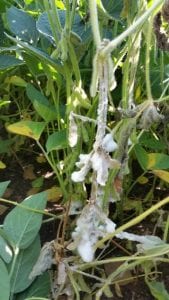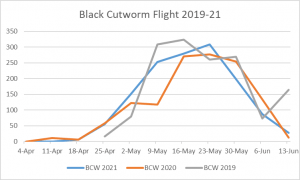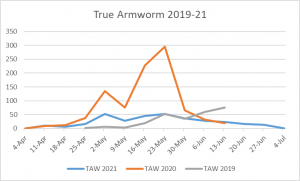NYS Weekly Field Crops Pest Report
Soybean Aphids
Again, this last week soybean aphids were reported in soybean fields in northern and western NY. There were also lady beetles, other predators, and parasitoids found in fields. Many times natural enemies of soybean aphids can keep a population below threshold. If your fields are close to the 250 aphids per plant and there are natural enemies it might be good to wait a few days and monitor again to see if the population is still rising or staying below threshold.
For more information, please view the following publication or video.
A Visual Guide to Counting Soybean Aphids
Video on IPM for Soybean Aphids on Soybeans
Potato Leafhopper
There were some reports of potato leafhopper (PLH) in alfalfa at moderate populations. Make sure if you are harvesting with moderate to high populations of PLH harvest the whole field. If you only harvest part of the field, it serves as a reservoir for the PLH to infest the smaller plants.
Large populations of nymphs on the plants combined with adult PLH is when you really start seeing yellowing plants. Once you see yellowing the damage has occurred and you have lost yield and quality in the alfalfa.
So scout your fields weekly and avoid damage!
For more information on thresholds and management, view the following video:
IPM for Potato Leafhopper on Alfalfa
Western Bean Cutworm
We had very low number of western bean cutworm moths caught this last week. Flights will start to increase in the next few weeks. Peak flight is normally the last week in July or the first week in August. Many trap counts have not been reported yet. Many of the traps were place out last week. We will have more data this coming week. See trap counts in the table below.
White Mold in Soybeans
Because of the excess in moisture, this last week may have created prime conditions for white mold in soybeans. If the soybean canopy closes as the beans get taller creates conditions for white mold. For more information, view the following scouting video and publication: White Mold or Sclerotinia Stem Rot
Black Cutworm and True Armyworm in 2019-2021
The following are the number of moths caught across the state for black cutworm and true armyworm by week. As seen in the graph for black cutworm they have a very similar flight pattern of the 3 years presented. There were several fields across NYS that were over threshold for black cutworm this year. We were able to identify large moth flights across NYS and calculate the black cutworm degree-days to determine when to scout the fields for larvae for each trap location. This helped growers and crop consultants identify fields that may have had potential damage.
True armyworm flights were very low this year. I did not have any record or communication on fields that might have been over threshold in corn this year for true armyworm. We are going to continue to monitor for true armyworm into mid-July. Last year we had some armyworm damage later in the season that we normally see. We want to make sure we do not have any large flights in July. Last year there were infestation in sorghum-Sudan grass.
Western Bean Cutworm Trap Counts by Location
Clipboard Checklist
Keith Waldron, NYS IPM
General
*Walk fields to check general field condition, weed issues
*Watch for crop maturity, stand assessments, weed escapes, nutrient deficiencies, lodging issues
Alfalfa:
*Evaluate established legume stands for approximate days until harvest
*Monitor potato leafhopper, foliar, systemic and crown rot diseases.
*Monitor new seedings for potato leafhopper, pythium blight, phytopthora root rot.
Small Grains:
*Monitor small grains for signs of Fusarium Head Blight, foliar diseases
*Monitor grain fields for growth stage, disease issues, grain maturity, harvest timing
*Record diseases present, location and types of weed escapes
Corn:
*Monitor for mid-season corn pests including European corn borer, corn rootworm, western bean cutworm, slugs, foliar diseases such as northern corn leaf blight and gray leaf spot, weed issues, nutrient deficiencies, vertebrate damage.
Soybeans:
*Monitor for crop growth stage, soybean aphid, defoliators, foliar diseases, white mold, weed issues, vertebrate damage
Pastures:
*Check water sources, mend fences as needed.
*Check crop growth, clip pastures between grazing as needed
*Monitor for invasive species, plants harmful to livestock
*Review/Plan rotations
Equipment:
*Carry appropriate / necessary NYS DEC and EPA documents as needed: (pesticide applicators license, pesticide labels, MSDS sheets, etc.)
Storage:
* Check stored grain bins for temperature, moisture and signs of mold and insects. Aerate, core, transfer grain or treat as necessary
* Clean and disinfect empty storage bins in preparation for grain harvest
*Check forage allocation and anticipate feed program adjustments as forages from previous year are used up
*Mow around storage bins and facility to minimize pest hiding places
Dairy Cattle Barn Fly Management:
*Monitor animals and barn area for house fly, stable fly and other pest management needs including presence of rodents and birds.
*Check facilities for favorable fly breeding conditions: (organic matter + moisture): leaks in watering systems, roof gutters for leaks and potential overspill, drainage,
*Sanitation, sanitation, sanitation – clean animal resting areas, feed troughs, minimize source of moist organic matter i.e. fly breeding areas in barn and in adjacent animal loafing yard
* Continue fly monitoring: install “3X5″ index card fly speck monitoring cards throughout barn
*Use, replenish, replace fly management materials: sticky fly tapes/ribbons, insecticide baits, natural enemies (parasitoids), fly population monitoring (3 x 5) spot cards
*Consider purchase and release of Muscidifurax raptor and/or M. raptorellus natural enemies of house and stable fly pupae.
Dairy Cattle on Pasture:
*Monitor animals for presence of face flies, horn flies and stable flies. Action guidelines: face flies (average 10 per animal face), horn flies (average 50 / dairy per animal side, 200 / beef cattle per animal side), stable flies average 10 per animal (all four legs)
*Check feed bunk / water source locations for signs of stable fly breeding (moist undisturbed organic matter – spilled feed, round bales, etc.), minimize source of moist organic matter i.e. fly breeding areas in barn and in adjacent animal exercise yard.
*Check pasture for forage quality / quantity, rotate as appropriate
*Check pasture for vegetation poisonous to livestock
*Consider use of pasture fly traps to help reduce deer, horse and stable fly populations

